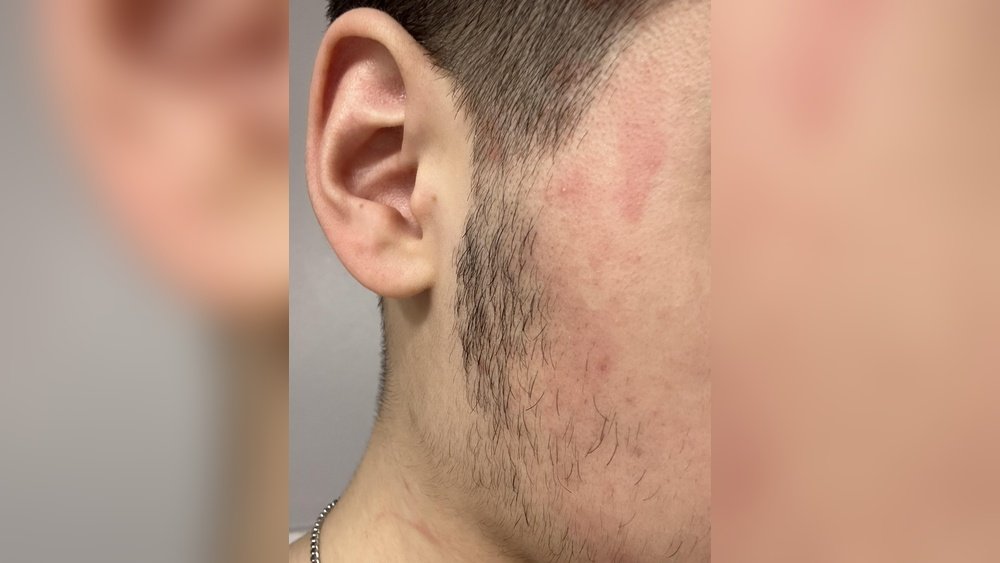Have you ever noticed your face turning red right after cleansing? It can be frustrating and even a little alarming.
You might wonder if it’s normal or if something’s wrong with your skin. The truth is, redness after washing your face is a common sign that your skin is reacting to something—whether it’s the cleanser itself, how you’re using it, or your skin’s sensitivity.
Understanding why this happens is key to stopping the irritation and keeping your skin calm and healthy. Keep reading, and you’ll discover the surprising reasons behind that redness and simple steps you can take to soothe your skin every time you cleanse.

Credit: clarusdermatology.com
Common Causes Of Redness
Redness after cleansing is a common skin reaction. It often signals that something in your routine or environment affects your skin. Understanding the causes helps you manage and prevent this issue.
Redness can result from various factors. These include the products you use, how you cleanse, and the condition of your skin barrier.
Irritation From Ingredients
Some skincare ingredients can irritate your skin. Harsh chemicals, fragrances, and alcohol often cause redness. Even natural extracts may trigger reactions in sensitive skin. Irritation happens when these substances disturb the skin’s balance. Look for gentle, soothing ingredients to reduce this risk.
Damaged Skin Barrier
The skin barrier protects your skin from irritants and moisture loss. Over-cleansing or using strong products can weaken this barrier. A damaged barrier makes your skin more vulnerable to redness and sensitivity. Repairing it with moisturizers and barrier-friendly products is key to calming redness.
Sensitivity To Water Temperature
Water that is too hot can cause redness after cleansing. Hot water strips natural oils and irritates skin. Cold water is gentler and helps close pores. Using lukewarm water is best to avoid flushing or redness. Adjust your cleansing routine to protect your skin’s comfort.

Credit: health.howstuffworks.com
Impact Of Skin Conditions
Skin conditions play a big role in causing redness after cleansing. Some conditions make skin more sensitive. This sensitivity leads to irritation and visible redness. Understanding these conditions helps in managing skin care better.
Different skin issues cause redness for different reasons. Knowing the specific cause guides the choice of gentle products and routines.
Rosacea And Redness
Rosacea is a common skin condition that causes redness. It often affects the cheeks and nose. People with rosacea have fragile blood vessels close to the skin’s surface. Cleansing can trigger flare-ups and increase redness. Using harsh cleansers can worsen the symptoms. Gentle, soothing cleansers are best for rosacea-prone skin.
Acne And Inflammation
Acne causes inflammation and redness in the skin. Cleansing helps remove excess oil and dirt. But aggressive cleansing can irritate acne lesions. This makes redness and swelling worse. Choosing mild, non-comedogenic cleansers reduces irritation. Avoid scrubbing too hard to keep inflammation down.
Other Inflammatory Disorders
Conditions like eczema and psoriasis also cause redness after cleansing. These disorders weaken the skin barrier. The skin becomes more prone to irritation and dryness. Using moisturizing, fragrance-free cleansers soothes the skin. Avoid products with alcohol or strong chemicals. Gentle care supports healing and reduces redness.
Cleansing Mistakes To Avoid
Redness after cleansing often results from common cleansing mistakes. These errors can irritate the skin and disrupt its natural balance. Understanding these mistakes helps protect your skin and keep it calm.
Over-exfoliation
Exfoliating removes dead skin cells but doing it too often harms your skin. Over-exfoliation strips away the protective barrier. This leads to redness, dryness, and sensitivity. Limit exfoliation to 1-2 times per week to avoid irritation.
Rough Towels And Scrubbing
Using rough towels or scrubbing your face harshly causes skin damage. The skin on your face is delicate and needs gentle care. Pat your face dry with a soft towel instead of rubbing. Gentle handling prevents redness and inflammation.
Harsh Cleansing Products
Many cleansers contain strong ingredients that irritate sensitive skin. Ingredients like alcohol, fragrance, and sulfates can cause redness. Choose mild, fragrance-free cleansers designed for sensitive skin. This protects your skin’s natural moisture and reduces redness.
Role Of Sensitive Skin
Sensitive skin often reacts easily after cleansing. It may show redness, burning, or itching.
This happens because sensitive skin has a weaker defense system. It cannot protect itself well from irritants.
Understanding how sensitive skin works can help reduce redness after washing your face.
Weakened Skin Barrier Effects
The skin barrier keeps moisture in and harmful agents out. Sensitive skin has a fragile barrier.
This allows water to escape and irritants to enter. The skin becomes dry, tight, and red.
Repeated cleansing with harsh products worsens this damage and increases redness.
Common Irritants To Watch For
Sensitive skin reacts to many common ingredients. Fragrances, alcohol, and synthetic dyes are top culprits.
Harsh soaps and exfoliants also strip natural oils. This leaves skin vulnerable and inflamed.
Choosing gentle, fragrance-free cleansers helps protect sensitive skin from irritation.
How Sensitivity Triggers Redness
Sensitive skin has an overactive immune response. It releases chemicals that cause redness and swelling.
Even mild cleansing can trigger this reaction. The skin’s blood vessels widen, making redness visible.
Reducing triggers and using calming products lowers redness and soothes sensitive skin.
Quick Fixes For Redness
Redness after cleansing often signals irritation or sensitivity. Quick fixes can help calm your skin and prevent further redness. Simple changes in your routine provide relief and protect your skin barrier. These easy steps soothe and restore comfort quickly.
Choosing Gentle Cleansers
Select cleansers with mild, fragrance-free formulas. Avoid harsh chemicals like alcohol and sulfates. Look for products labeled “for sensitive skin” or “hydrating.” These gentle cleansers clean without stripping natural oils. This reduces irritation and redness after washing.
Adjusting Water Temperature
Use lukewarm water instead of hot water. Hot water can dry out and inflame skin. Lukewarm water cleans gently and keeps skin balanced. This small change helps reduce redness and discomfort.
Soothing Aftercare Tips
Apply a calming moisturizer immediately after cleansing. Choose ones with ingredients like aloe vera or chamomile. Avoid heavy rubbing; pat your face dry with a soft towel. These soothing steps help your skin heal and stay calm.
Preventing Future Redness
Preventing future redness after cleansing is key to keeping your skin calm and healthy. Redness often signals irritation or a damaged skin barrier. Adjusting your skincare habits helps protect your skin from these issues. Small changes create big improvements in how your skin looks and feels.
Building A Balanced Routine
Use gentle cleansers that suit your skin type. Avoid harsh soaps or scrubs that strip natural oils. Cleanse your face twice daily, but do not over-wash. Follow cleansing with soothing products to calm the skin. A balanced routine supports your skin’s natural barrier and reduces redness.
Patch Testing New Products
Try new skincare items on a small skin area first. Wait 24 to 48 hours to check for reactions. This step helps identify allergic or irritant responses early. Patch testing avoids widespread redness and discomfort. It’s a simple way to protect sensitive skin from harm.
Maintaining Skin Hydration
Hydrated skin is less prone to redness and irritation. Apply a gentle moisturizer right after cleansing. Choose products with calming ingredients like aloe or chamomile. Drink plenty of water daily to keep skin hydrated from inside. Proper hydration supports healing and strengthens skin resilience.

Credit: www.reddit.com
Frequently Asked Questions
Is It Normal For The Face To Be Red After Cleanser?
Redness after cleansing often indicates skin irritation or sensitivity. It may result from harsh ingredients, allergic reactions, or damaged moisture barriers. Use gentle cleansers and avoid scrubbing to reduce redness and protect your skin. Persistent redness may require dermatologist advice.
Can Cleansing Cause Redness?
Cleansing can cause redness if you use harsh products or scrub too hard. Sensitive skin reacts easily to irritation.
Is It Normal For Your Skin To Turn Red After Skincare?
Yes, mild redness after skincare is common, especially with sensitive skin or new products. It often signals irritation or a weakened skin barrier. Avoid harsh ingredients and scrubbing to reduce redness. If redness persists or worsens, consult a dermatologist for proper care.
Why Does My Skin Turn Red After Cleansing?
Redness after cleansing often indicates skin irritation or a weakened moisture barrier. Harsh ingredients or over-cleansing can strip natural oils, causing redness and sensitivity.
Conclusion
Redness after cleansing often signals skin irritation or sensitivity. Harsh cleansers and rough scrubbing can damage your skin’s protective barrier. Using gentle products and soft materials helps reduce redness and discomfort. Pay attention to ingredients that may trigger reactions, like alcohol or fragrances.
Consistent care supports healthier, calmer skin over time. Remember, mild redness is common but persistent irritation needs attention. Taking simple steps can soothe your skin and improve its appearance. Keep your routine gentle and watch your skin respond positively.
 Skip to content
Skip to content 